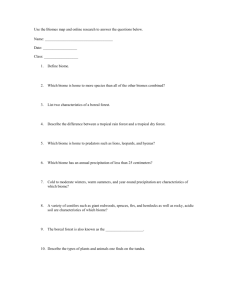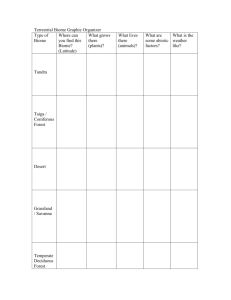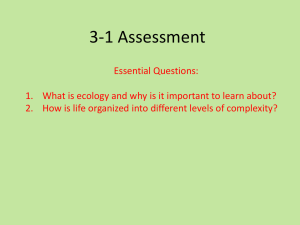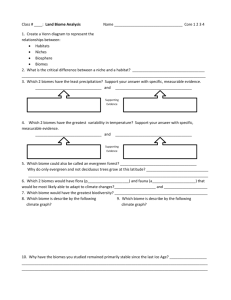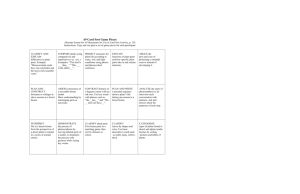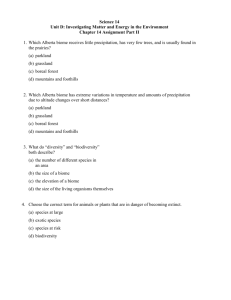Biome Test
advertisement
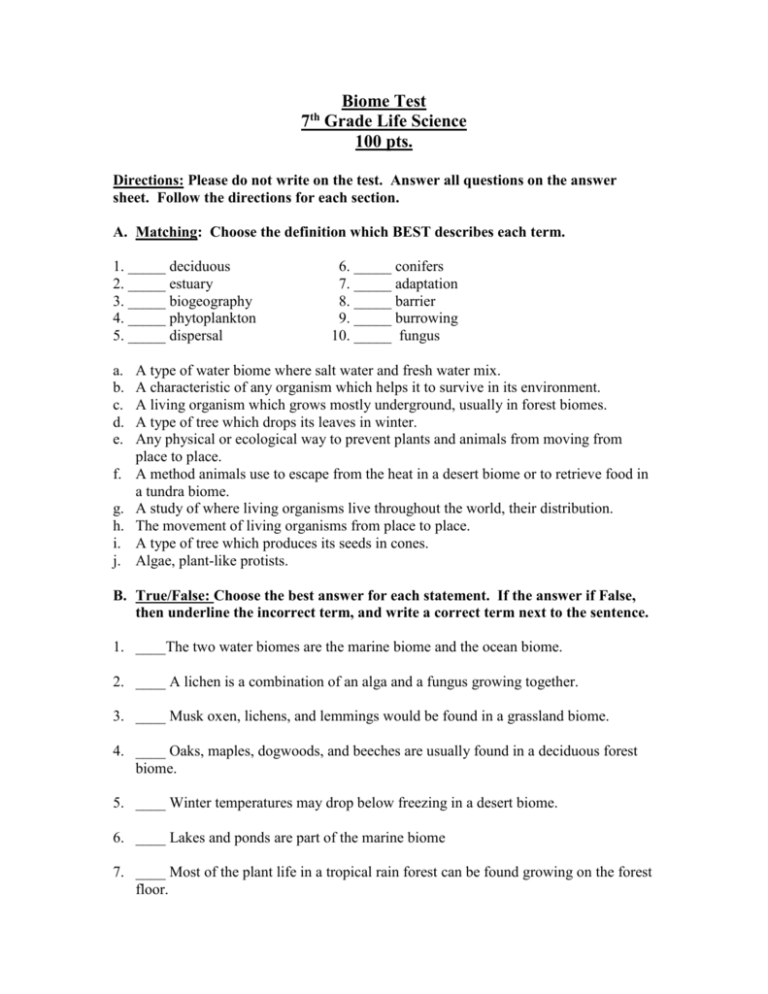
Biome Test 7 Grade Life Science 100 pts. th Directions: Please do not write on the test. Answer all questions on the answer sheet. Follow the directions for each section. A. Matching: Choose the definition which BEST describes each term. 1. _____ deciduous 2. _____ estuary 3. _____ biogeography 4. _____ phytoplankton 5. _____ dispersal a. b. c. d. e. f. g. h. i. j. 6. _____ conifers 7. _____ adaptation 8. _____ barrier 9. _____ burrowing 10. _____ fungus A type of water biome where salt water and fresh water mix. A characteristic of any organism which helps it to survive in its environment. A living organism which grows mostly underground, usually in forest biomes. A type of tree which drops its leaves in winter. Any physical or ecological way to prevent plants and animals from moving from place to place. A method animals use to escape from the heat in a desert biome or to retrieve food in a tundra biome. A study of where living organisms live throughout the world, their distribution. The movement of living organisms from place to place. A type of tree which produces its seeds in cones. Algae, plant-like protists. B. True/False: Choose the best answer for each statement. If the answer if False, then underline the incorrect term, and write a correct term next to the sentence. 1. ____The two water biomes are the marine biome and the ocean biome. 2. ____ A lichen is a combination of an alga and a fungus growing together. 3. ____ Musk oxen, lichens, and lemmings would be found in a grassland biome. 4. ____ Oaks, maples, dogwoods, and beeches are usually found in a deciduous forest biome. 5. ____ Winter temperatures may drop below freezing in a desert biome. 6. ____ Lakes and ponds are part of the marine biome 7. ____ Most of the plant life in a tropical rain forest can be found growing on the forest floor. 8. ____ Yeasts grow the most in a warm, dark, wet environment. 9. ____ Desert and grasslands biomes are similar in that they both have high average temperatures and low average rainfall. 10. ____ The best insulator in the “Adapting to the Cold” Lab was the sock. C. Multiple Choice: Choose the answer which BEST fits the statement. 1. What is the average weather in a particular place over a long period of time called? a. Habitat c. biome b. Ecosystem d. climate 2. Which biome has a climate that is very cold and dry? a. Coniferous forest c. deciduous forest b. Tundra d. grassland 3. Most coniferous trees are also known as a. palms c. cacti b. gymnosperms d. algae 4. A grassland with scattered trees is called a a. taiga c. canopy b. tundra d. savanna 5. Which biome usually contains orchids, ferns, and other plants that live on the branches of trees? a. tundra c. deciduous forest b. coniferous forest d. tropical rain forest 6. The freshwater biome includes all of the following EXCEPT a. lakes c. oceans b. ponds d. streams 7. Not many trees grow in a grassland biome because of low rainfall, fires, and a. animals c. freezing temperatures b. high winds d. floods 8. The greatest variety of species of living organisms is found in a(an) a. rain forest c. taiga b. desert d. estuary 9. Protists are organisms which a. are unicellular. c. can be animal-like or plant-like. b. have a nucleus. d. are all of the above. 9. The giant fungus which we studied is located in a. South Florida c. South America b. Michigan’s Upper Peninsula d. The Asian Continent D. Completion: Choose an answer which BEST completes each statement. 1. The largest grassland is found in _______________. 2. One of the more interesting animals, because of its unusual behaviors, found in the tundra is the ___________________. 3. The top layer of a forest is called a ________________. 4. Microscopic plants known as ____________ are found near the surface of marine biomes. 5. The permanently frozen ground beneath the surface of the tundra is known as __________________. 6. Any animal that preys upon another animal is called a ___________. 7. Fungus tentacles which invade and dissolve dead tree roots for their food are called __________________. 8. A single-celled fungus is called a ____________. 9. Something that prevents heat from escaping is called a ____________. 10. The smallest living organisms are called _________________. E. Short Answers: 1. Choose a biome and describe at least two major plant adaptations and two major animal adaptations to that environment. 2. Why is climate an important factor in dividing the Earth into biomes? 3. What effect might population growth in the area around the Chesapeake Bay have on the ecology of the Bay? How might this affect the area’s economy? What do you think can be done to protect the Bay? 4. Use the following graphs to answer the questions: What type of biome is Biome A, Biome B, and Biome C? And how do you know?
